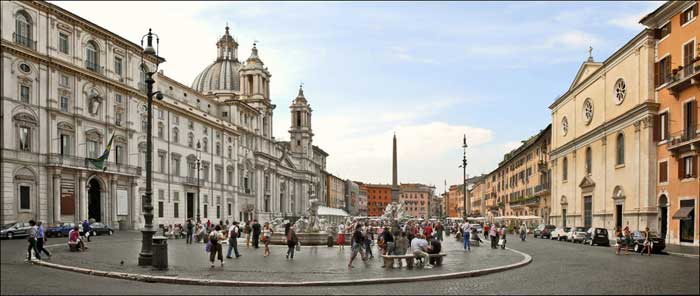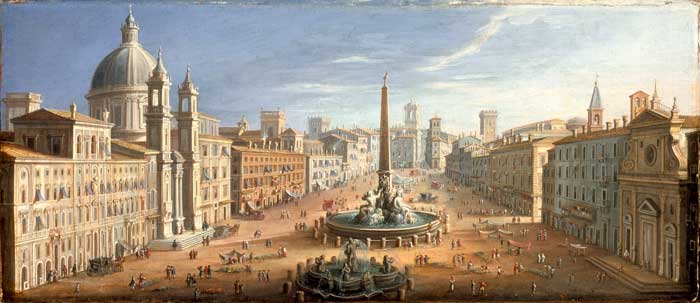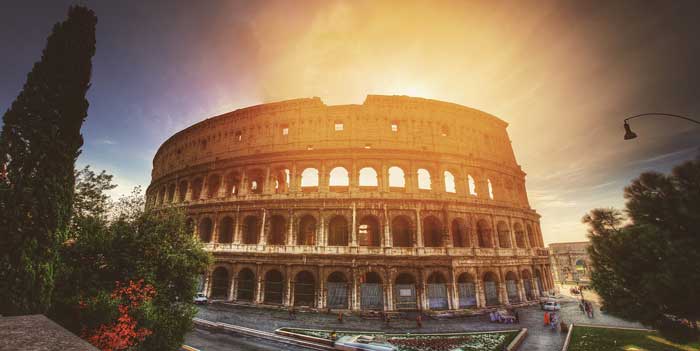Four Rivers Fountain, Piazza Navona

The Piazza Navona is one of the largest squares in the historic centre of Rome and has the form of a stadium. It was indeed the Stadium of Domitian —Stadio di Domiziano in Italian— for athletic contests and it remained almost unchanged until 1450.
It was built by the Roman Emperor Domitian in the 1st century AD and was known also as Circus Agonalis or Competition Arena where Romans went to see the agones or games. Over time the name became corrupted and finally became Navona.

Photo by Jean-Pierre Dalbera
Piazza Navona Fountains
In the center of the piazza stands the Fontana dei Quattro Fiumi, Fountain of the Four Rivers in English, built in 1651 by Gian Lorenzo Bernini, which is topped by an obelisk that was brought here from the Maxentius’ Circus in the Via Appia.
The central fountain represents four allegorical figures of the longest river in each continent known at the time: the Danube, the Ganges, the Nile and the River Plate.
In front of Bernini’s fountain and next to the Palazzo Pamphilj we see the church of Sant’Agnese in Agone by Francesco Borromini, Girolamo Rainaldi and others facing onto the Piazza Navona. It was precisely here, in the Domitian Stadium, where the early Christian Saint Agnes was martyred.
There are two more fountains in the Piazza Navona: at the southern end, the Fontana del Moro, in English Moor Fountain, by Giacomo della Porta and Bernini and at the north end the Fontana del Nettuno meaning Fountain of Neptune sculpted by Giacomo della Porta, Gregorio Zappalà and Antonio Della Bitta.
Ancient Talking Statues
A little further, at the southern end we can also see the Pasquino, erected in 1501, which is the most famous of the six ancient talking statues in Rome.
During the night Romans used to tie anonymous notes to Pasquino’s neck with short satirical criticism in verse form against the ruling class and leading public figures. They were called pasquinate and were a way for ordinary people to let off steam although they run a high risk of being caught and severely punished.
Piazza Navona History
The Piazza Navona in Rome has kept virtually the same outline of the original Domitian’s Stadium and it was used for jousts, shows, theatrical events and celebrations well into the 19th century. Nowadays, in December the piazza fills with booths for the Christmas market that is held in the piazza. In the Piazza Navona past meets present without interruption.

Piazza Navona ca. 1730 by Flemish Painter Hendrik Frans van Lint
In the final years of the 15th century the piazza became a public space. In 1477 Sixtus IV transferred the market of Campidoglio to it and soon after it was paved over but it was Pope Innocent X (1644-55), who gave it its present glory. His family palace, the Palazzo Pamphilj, faced the piazza Navona, and the Pope transformed the piazza into an eloquent example of splendid Roman baroque with its impressive fountains and sculptures by renowned artists of the time.
Click the button below to check out the photo gallery showing the different fountains and aspects of the famous Rome Piazza Navona






